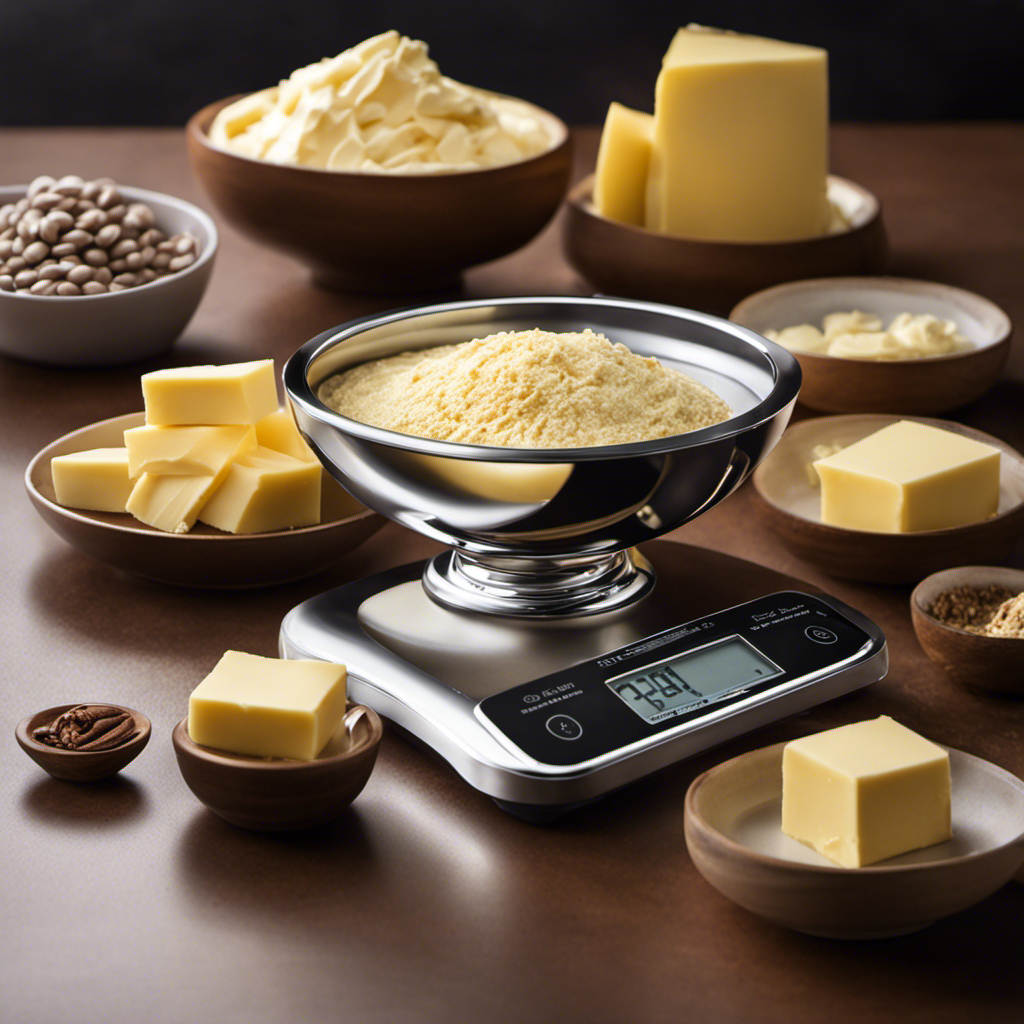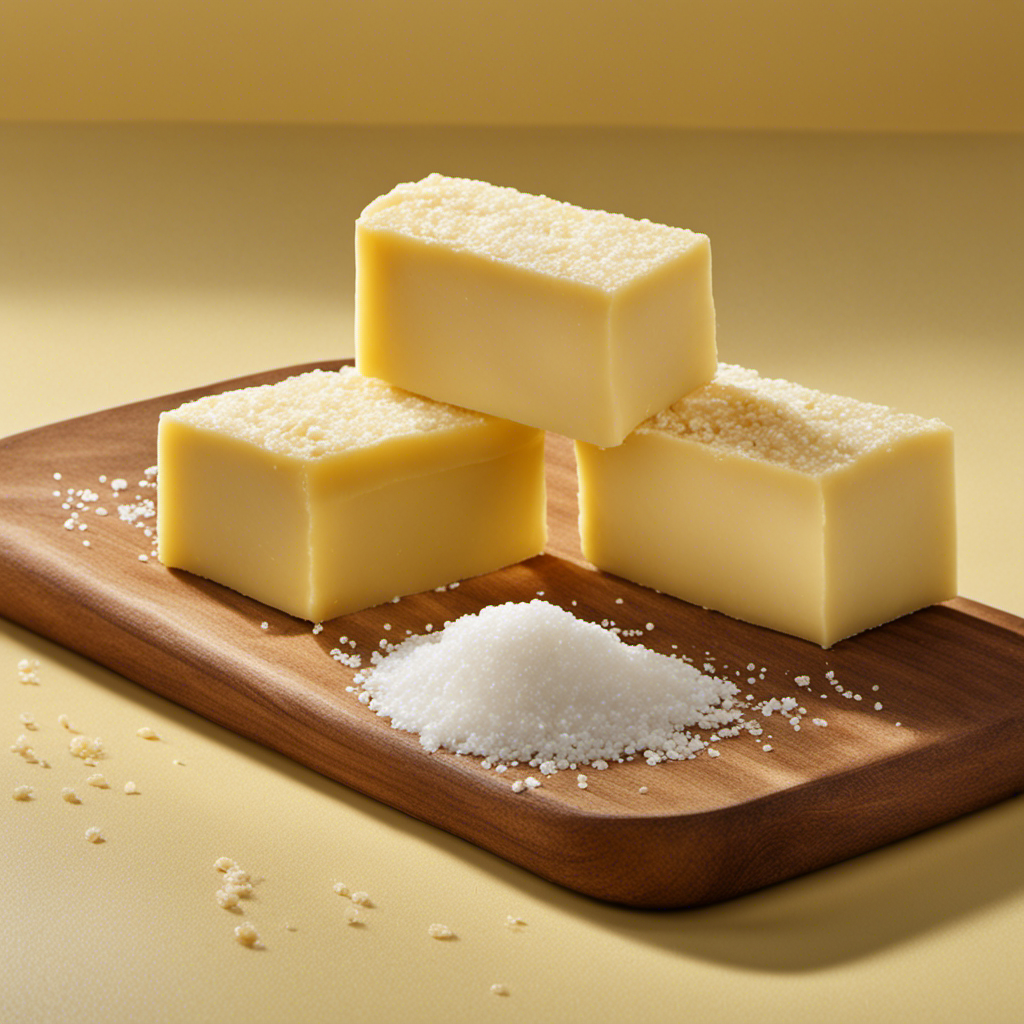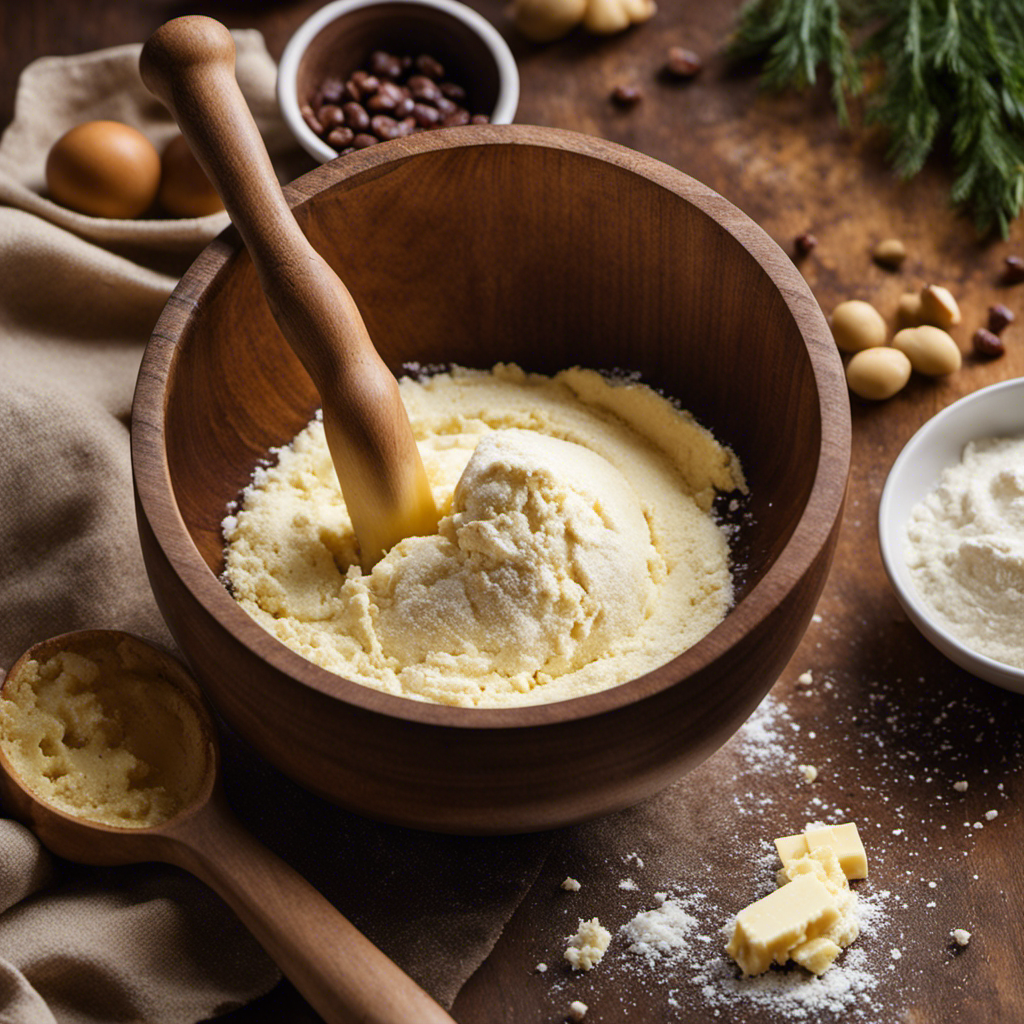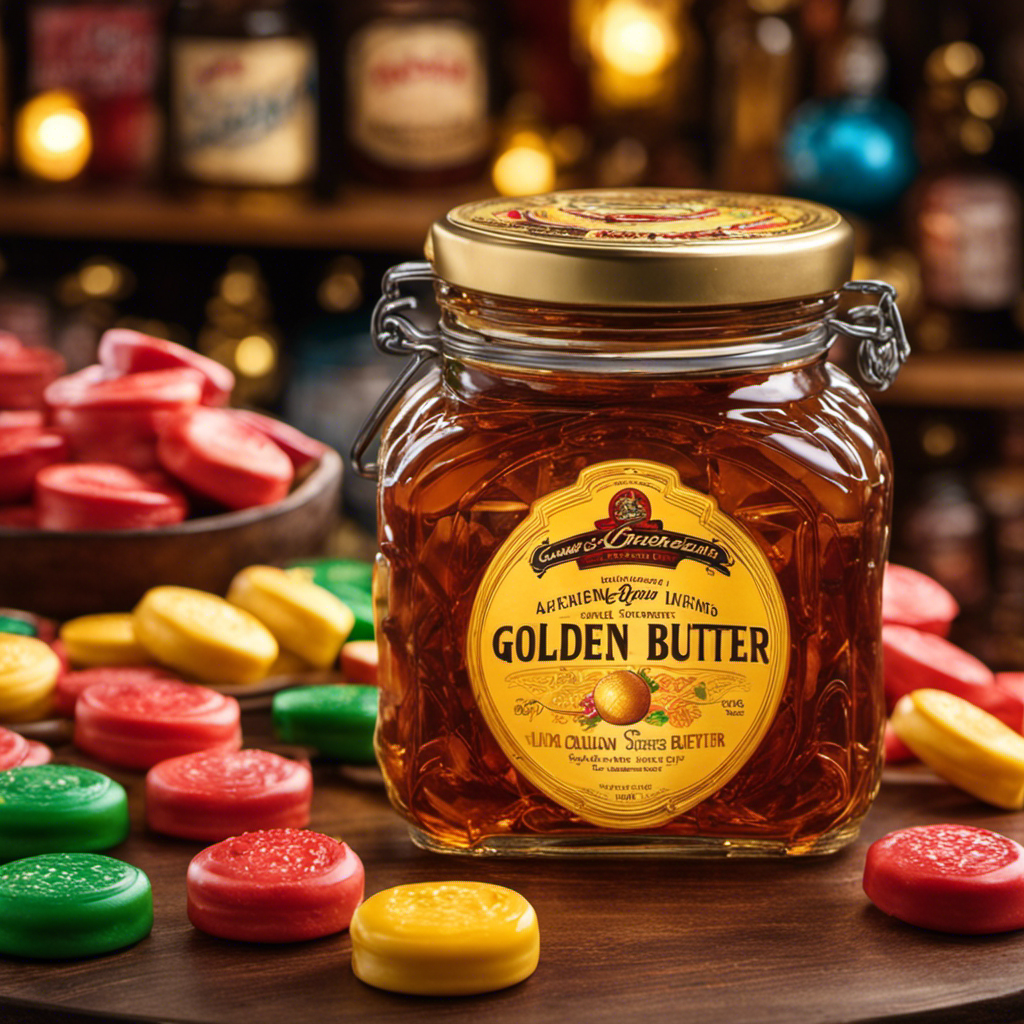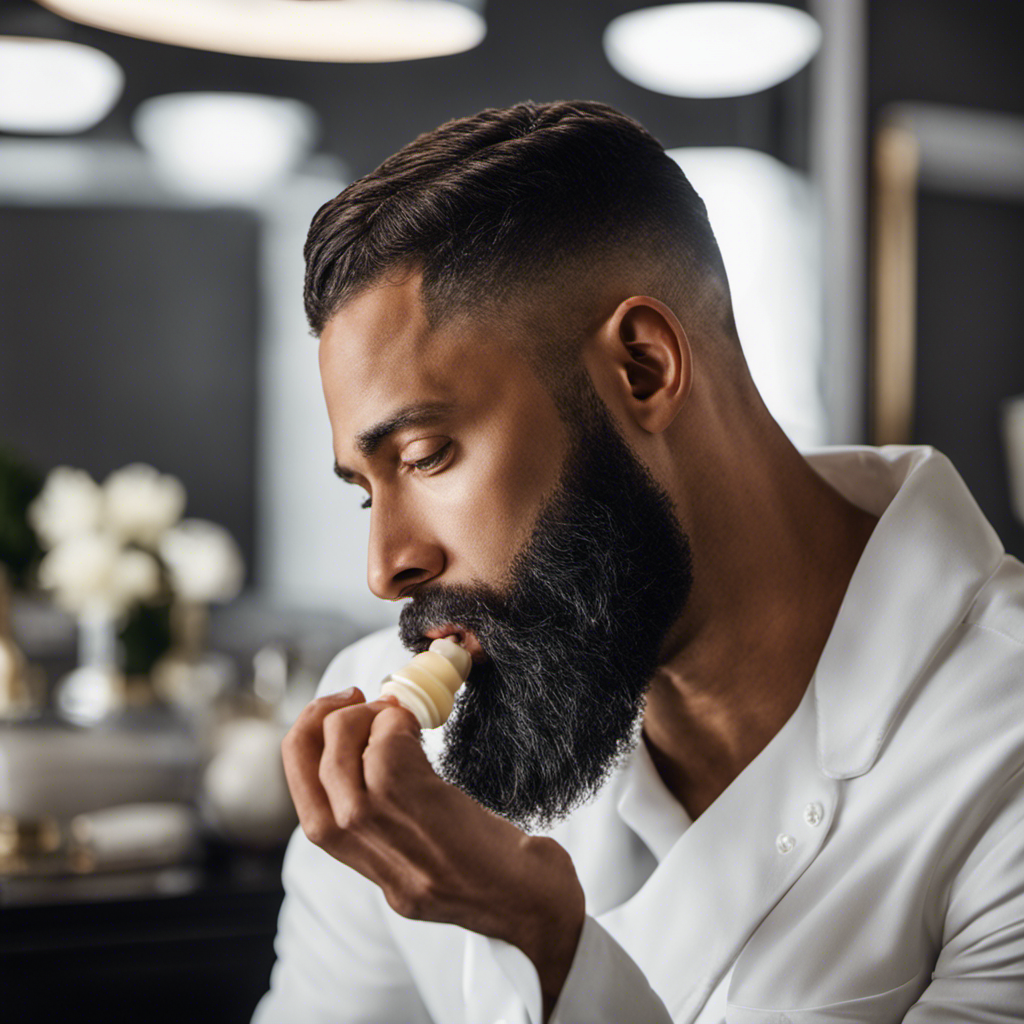I’ve always been curious, what is the precise measurement for 2/3 cup of butter? It’s frequently used in recipes for baking, and achieving the correct measurement is vital for a recipe’s outcome.
In this article, we’ll dive into the world of butter measurements and conversions, exploring how to accurately measure and convert 2/3 cup of butter.
Whether you’re a seasoned baker or just starting out, understanding butter measurements is key. So let’s explore the science behind it and ensure your next batch of cookies turns out perfectly.
Key Takeaways
- 2/3 cup of butter is equivalent to about 10 and 2/3 tablespoons of butter.
- Accurately measuring butter is important for achieving the desired taste and texture in dishes.
- Understanding butter measurements allows for precise recipe execution.
- Conversion charts can help with converting butter measurements to different units.
Understanding Butter Measurements
To understand butter measurements, you’ll need to know how much 2/3 cup of butter is. Calculating butter ratios and understanding butter measurements for cooking are essential skills in the kitchen.
Butter is commonly used in recipes to add flavor, moisture, and richness to dishes. When a recipe calls for 2/3 cup of butter, it means you need to measure out two-thirds of a standard measuring cup of butter. This is equivalent to about 10 and 2/3 tablespoons of butter.
Understanding butter measurements allows you to accurately follow recipes and achieve the desired taste and texture in your dishes. Now that we know how much 2/3 cup of butter is, let’s move on to the next section about converting it into other measurements.
Converting 2/3 Cup of Butter
When it comes to baking, understanding butter measurements is crucial. Knowing the equivalents of different butter measurements can help ensure accurate results in recipes.
Additionally, being able to convert butter measurements to different units allows for flexibility in adjusting recipes to suit personal preferences or dietary restrictions.
Butter Measurement Equivalents
You can easily convert 2/3 cup of butter to grams or ounces using a measurement conversion chart. Understanding butter measurements is essential when adjusting recipes that call for specific quantities of butter.
In the United States, butter is commonly measured in cups, tablespoons, and sticks. However, in other countries, butter may be measured in grams or ounces.
To convert 2/3 cup of butter to grams, you can multiply the cup measurement by the conversion factor of 227 grams per cup. This will give you approximately 151 grams of butter.
If you prefer to convert to ounces, the conversion factor is 8 ounces per cup, resulting in approximately 5.33 ounces of butter.
Now that we have converted 2/3 cup of butter to different units, let’s explore other butter measurement equivalents.
Converting to Different Units
Understanding different units of measurement for butter is essential when adjusting recipes. Measuring butter accurately can make or break a dish, so it’s important to know the conversions.
In the United States, butter is typically sold in sticks, with each stick being 1/2 cup or 8 tablespoons. If your recipe calls for a different unit, such as grams or ounces, it’s helpful to know the conversion factors. For example, 1 stick of butter is equivalent to 113 grams or 4 ounces.
Knowing these conversions allows you to accurately measure butter regardless of the unit specified in the recipe.
Now that we understand the different units of measurement for butter, let’s explore how to adjust recipes with butter to achieve the perfect balance of flavor and texture.
Adjusting Recipes With Butter
Using butter in recipes can enhance the flavor and texture of dishes. However, when adjusting butter for vegan recipes or for those who prefer to avoid dairy, alternative fats can be used in place of butter.
One popular substitute is coconut oil, which adds a rich, tropical flavor to baked goods. Another option is avocado, which provides a creamy texture and healthy fats. For a nutty taste, almond butter can be used instead of butter. Additionally, vegetable shortening or margarine can be used as a direct replacement for butter in most recipes.
It is important to note that adjusting butter for vegan recipes may require some experimentation to achieve the desired taste and texture, but with these alternative fats, delicious vegan dishes can be easily created.
Calculating Butter Portions
To calculate butter portions, simply divide the total amount needed by the serving size.
Understanding butter portions is crucial when adjusting butter in recipes. When a recipe calls for a specific amount of butter, it is important to know how much to use in order to achieve the desired outcome. By dividing the total amount of butter needed by the serving size, you can determine the appropriate portion.
For example, if a recipe requires 1 cup of butter and serves 4 people, each person would receive 1/4 cup of butter. This method ensures that the butter is distributed evenly and accurately in the recipe.
Understanding butter portions allows for precise adjustments in recipes, ensuring the perfect balance of flavors and textures.
Butter Equivalents
When it comes to working with butter in recipes, it’s essential to have a good understanding of butter equivalents. A butter conversion chart can be a helpful tool in determining the correct amount of butter needed for a recipe.
In addition to that, it’s important to know that there are also various substitutes for butter that can be used in cooking and baking.
Lastly, accurately measuring butter is crucial for achieving the desired results in your culinary creations, so mastering the art of measuring butter accurately is a skill worth acquiring.
Butter Conversion Chart
If you’re wondering about butter conversions, a helpful resource is a butter conversion chart. It provides a comprehensive overview of different measurements for butter, allowing you to easily convert between cups, tablespoons, and grams. Here is a table that showcases some common conversions:
| Cups | Tablespoons | Grams |
|---|---|---|
| 1/4 | 4 | 57 |
| 1/2 | 8 | 113 |
| 3/4 | 12 | 170 |
| 1 | 16 | 227 |
| 1 1/2 | 24 | 340 |
Understanding butter substitutes can be useful when you run out of butter or if you’re looking for a healthier option. Some common substitutes include applesauce, mashed bananas, or Greek yogurt. When melting butter, it’s important to use low heat to prevent it from burning. You can melt butter in a saucepan on the stove or in the microwave, using short bursts of heat and stirring frequently. Now that we have covered butter conversions and tips for melting butter, let’s explore the world of substitutes for butter.
Substitute for Butter
Try using mashed avocados as a healthier alternative when you need a substitute for butter in your recipes. Avocados are not only delicious, but they also offer a range of health benefits. Here are four reasons why you should consider using mashed avocados instead of butter:
-
Avocados are a great source of healthy fats. They contain monounsaturated fats, which can help lower bad cholesterol levels and promote heart health.
-
Mashed avocados can add a creamy texture to your dishes, just like butter. Whether you’re baking, cooking, or spreading it on toast, avocados can provide that same mouthfeel without the added saturated fats.
-
Avocados are packed with essential nutrients, including vitamins E, C, and K, as well as potassium and fiber. These nutrients support overall health and can contribute to a well-balanced diet.
-
Unlike butter, mashed avocados are cholesterol-free. This makes them a suitable option for those watching their cholesterol levels or following a plant-based diet.
Measuring Butter Accurately
To measure butter accurately, simply use a kitchen scale and follow the recipe’s instructions for the correct amount. Measuring butter by weight ensures precise and consistent results in your recipes. Adjusting recipes with butter can be tricky if you rely solely on volume measurements like cups.
Butter has a different density and can vary in moisture content, which affects its weight. Using a scale eliminates the guesswork and ensures your baked goods turn out as intended. Additionally, it allows you to easily scale a recipe up or down by adjusting the weight of the butter accordingly.
Now, let’s explore how to convert butter measurements in cups to weight for more accurate results in your cooking and baking endeavors.
Butter Measurements in Cups
There’s no need to worry about converting 2/3 cup of butter into another measurement, because that’s the exact amount you’ll need.
When it comes to understanding butter consistency and different types of butter, it’s important to know that butter can vary in moisture content and fat content. Here are four key points to consider:
-
Salted vs. unsalted: Salted butter contains added salt, which can affect the taste and flavor of your dish. Unsalted butter is preferred in baking, as it allows for better control of the overall salt content.
-
European-style butter: This type of butter has a higher fat content compared to regular butter, resulting in a richer and creamier texture. It is often used in specialty baking and pastry making.
-
Clarified butter: Also known as ghee, clarified butter is made by removing the milk solids from butter. It has a higher smoke point and a longer shelf life, making it ideal for high-heat cooking and as a dairy-free alternative.
-
Whipped butter: Whipped butter is made by incorporating air into the butter, resulting in a lighter and fluffier texture. It spreads easily and is often used as a topping for bread or toast.
Understanding these different types of butter can help you choose the right one for your recipes and achieve the desired results.
How to Measure 2/3 Cup of Butter
Measuring 2/3 cup of butter is a simple task that can be done accurately using a measuring cup. When it comes to cooking, precise measurements are crucial for achieving the desired results. To help you measure 2/3 cup of butter, I have compiled some useful tips.
First, make sure your butter is at room temperature for easy measuring. Then, grab a measuring cup with clear markings. Fill the cup to the 2/3 mark, scraping off any excess butter from the top. If your butter comes in sticks, refer to the markings on the packaging to determine the correct amount.
Here’s a helpful table that provides conversions for measuring 2/3 cup of butter in different forms:
| Butter Form | Measurement |
|---|---|
| Sticks | 10 2/3 tbsp |
| Grams | 151 g |
| Ounces | 5.33 oz |
Butter Conversions for Baking Recipes
When baking, it’s important to know the different conversions for butter in order to achieve the desired results in your recipes. Here are four key points to consider:
-
Butter measurement conversions: Butter is often measured in cups, tablespoons, or grams. One cup of butter is equal to 226 grams or 16 tablespoons. To convert tablespoons to cups, divide the number of tablespoons by 16. For example, 8 tablespoons of butter is equal to half a cup.
-
Substituting butter: If you’re looking for a healthier alternative or if you have dietary restrictions, you can substitute butter with other ingredients like oil, margarine, or applesauce. Keep in mind that each substitute may alter the texture and taste of your baked goods.
-
Precision matters: When measuring butter, it’s important to be precise. Use a kitchen scale for accurate measurements or refer to a conversion chart to ensure your recipe’s success.
-
Experimentation: Baking is a science, but it’s also an art. Don’t be afraid to experiment with different butter measurements or substitutes to find the perfect balance for your taste preferences and dietary needs.
Frequently Asked Questions
Can I Use Margarine Instead of Butter in a Recipe That Calls for 2/3 Cup of Butter?
Yes, you can use margarine instead of butter in a recipe that calls for 2/3 cup of butter. It is a suitable substitute and will provide a similar texture and flavor to your dish.
How Many Sticks of Butter Are Equivalent to 2/3 Cup?
I can use 2/3 cup of shortening instead of butter in a recipe. Some alternative ingredients that can be used in place of butter for 2/3 cup include coconut oil or applesauce.
Can I Substitute Oil for Butter in a Recipe That Requires 2/3 Cup of Butter?
Yes, you can substitute oil for butter in a recipe that requires 2/3 cup of butter. Olive oil is a good alternative to butter and will provide a similar texture and flavor to your dish.
What Is the Weight of 2/3 Cup of Butter in Grams?
Weight conversion can be tricky when dealing with different measurements. When it comes to 2/3 cup of butter, it would be helpful to know the weight in grams for more accurate recipe substitutions.
Is It Possible to Use Unsalted Butter Instead of Salted Butter in a Recipe That Calls for 2/3 Cup of Butter?
Using unsalted butter in baking has pros and cons. Pros include more control over saltiness and a cleaner taste. To adjust salt, add 1/4 teaspoon of salt per 1/2 cup of unsalted butter.
Conclusion
In conclusion, the measurement of 2/3 cup of butter can be easily converted and calculated for various recipes. By understanding butter equivalents and measurements in cups, one can confidently measure the required amount.
Whether it’s for baking or cooking, knowing how to measure 2/3 cup of butter is essential. This precise knowledge will ensure accuracy and consistency in your culinary endeavors.
So, fear not the butter measurements, for they can be conquered with scientific precision and a touch of elegance.

